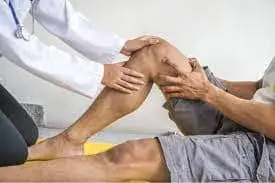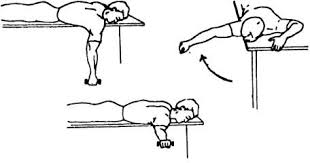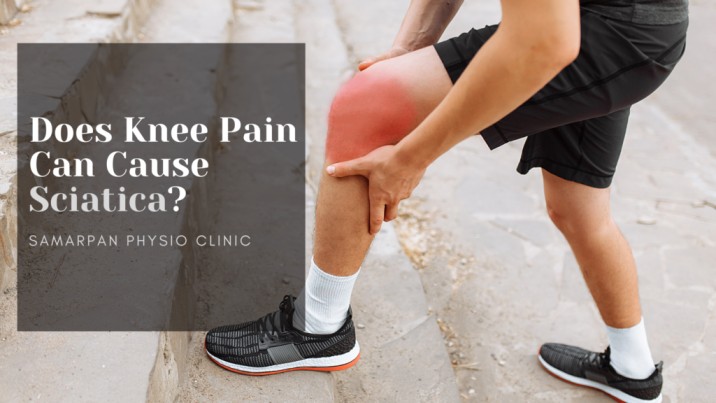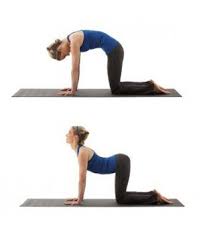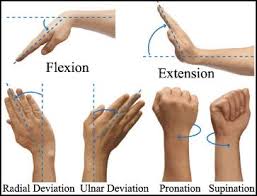30 Best Exercises Before Knee Replacement Surgery
Exercising before knee replacement surgery is important for improving overall fitness and getting ready your body for the surgery and recovery period of time. This basically means strengthening your knee muscles so that your body isn’t harmed by the surgery, you’ll heal from it quickly, and you’ll be prepared to support your new joints.
Exercises before knee replacement surgery may help you strengthen the muscles surrounding your knees, and this could significantly affect how quickly and effectively you heal from the surgery. We’ve included a list of exercises in this guide to help you achieve these objectives.
Why would people require a knee replacement, and what is it?
During a knee replacement procedure, your troubling knee joint is removed and replaced with an artificial joint made of plastic and metal. The replacement joint is attached to your thigh and shin bones with a special material that resembles acrylic cement.
If you have a restricted range of motion in your knee or knee pain, knee replacement surgery is frequently your last option. In case medication, injections, and physical therapy prove ineffective, your physician can suggest knee replacement surgery.
Introduction
By carrying out specific exercises before your knee replacement surgery, you can strengthen your knee, improve its flexibility, and speed up your rehabilitation.
However, before starting any new exercise program, it’s important to see your surgeon and physical therapist. Taking these steps will help the rehabilitation process move more quickly and effectively.
As a result of knee joint pain, you might have recognized a reduction in your level of activity. When your muscles aren’t used, they weaken and perform poorly when it comes to supporting and moving your body. Your knee replacement surgery will take care of the joint problem, but you’ll still need to work out on a regular basis to strengthen your muscles and support your new joint.
Before undergoing surgery, you can dramatically reduce the amount of time it takes for you to heal by beginning an exercise program. Make sure to complete the exercises on both sides in order to build strength. Since everyone reacts to exercise differently, you need to figure out how much you can do each day.
Before surgery, you should make an effort to work out every day. Perform each exercise five or ten times. Once you feel comfortable performing the exercise, go up in repetitions by one every week until you can perform a couple more.
Right before knee replacement surgery is the best time to prepare those joints so they can move freely! After a total knee replacement, patients with knee pain may experience an improvement in their freedom and mobility. When someone has severe osteoarthritis and is over fifty, knee replacements are frequently recommended.
Who could require surgery for a Knee Replacement?
Although various exercises and home remedies can give short-term relief from knee pain, knee replacement surgery may be required for individuals who’s knees suffered serious harm due to conditions like osteoarthritis, rheumatoid arthritis, or post-traumatic joint injury.
The following symptoms could point to the necessity for knee replacement surgery:
- Getting around, sitting, standing, and climbing stairs are challenging.
- Other therapies and treatments don’t work.
- knee pain that is both sudden and relentless.
- Movement is becoming increasingly restricted.
- Inflammation in the close by of the knee.
- Daily tasks start to feel difficult.
- You’re not in the mood to do the activities you used to enjoy.
Does it advantageous to exercise following knee replacement surgery?
Exercise is generally very good for your body. Exercise has the ability to strengthen the muscles that support your knees and may even increase knee mobility. If you have knee pain or conditions like osteoarthritis, rheumatoid arthritis, or post-traumatic arthritis, it is always best to speak with your doctor and a highly qualified physical therapist to determine which exercises are safe to perform and which ones should be avoided.
This will help you create an exercise routine that recognizes the requirements and limitations of your body. That being said, if you have severe knee damage, knee replacement surgery is an easy option that you may look into. The exercises that your physical therapist suggests could speed up your recovery from knee replacement surgery.
Significant Functional Goals for Achieving Before Surgery
Patients recover more quickly after surgery if they take part in a “knee replacement rehabilitation” program, which is a pre-operative physical therapy regimen that usually starts six to eight weeks before the procedure.
Following knee replacement surgery, you will try to achieve the following goals by performing the suggested stretches and workouts.
Goal 1: Develop Your Knee Joint’s Range of Motion
Increase the knee joint’s range of motion as much as you can( without considerably getting worse joint pain.
Goal 2: Enhanced Leg Power
Boost your strength in the quadriceps, glutes, hamstrings, and calf muscles all of which support your knee joint.
Goal 3: Boost Your Flexibility
Increase the flexibility of your quadriceps, hip flexors, hamstrings, and calf muscles.
Advantages of Prior Training
Exercise therapy performed six weeks or more before joint replacement surgery is known as pre-habilitation. These concentrate on strengthening, stretching, and endurance for knee replacement surgery.
Pre-habilitation provides additional benefits outside of simply preparing you for recovery, such as;
- Before surgery, reducing stiffness and maintaining pain levels.
- Increased strength: Strong muscles allow you to regain your independence and support your new knee.
- Increased flexibility: It gets easier and less painful to bend and straighten.
- Exercise helps reduce inflammation and pain before surgery.
- Reducing the possibility of needing hospitalization
- Improved general fitness: You’ll be more able to cope with the pressures of surgery and recuperation.
- Shorter hospital stays since you recover more quickly
General advice for strengthening exercises:
Before having joint replacement surgery, your leg muscles will typically weakening, or decrease. Exercise can improve nerve signals to muscles, allowing them to operate more efficiently and regain strength. It’s important to work your leg muscles in a variety of ways to improve overall performance.
- Warm-up and stretching are typically followed by strengthening exercises.
- Remember to use your muscles to go back to your starting posture carefully.
- In between each repetition, take a deep breath and relax for five seconds.
- Giving yourself five to ten minutes to relax after working out is crucial.
- This should include cold packs for muscle pain and a few stretches
Even though some discomfort in the muscles is expected, these workouts should not cause pain.
If you experience pain, relax and change your posture. If discomfort continues, postpone the specific difficult exercise.
General advice for stretching exercises:
By preparing the muscles for exercise, stretching aids in the prevention of injury. Before exercising, patients are usually recommended to stretch for five to ten minutes.
- Walk for five to ten minutes as a warm-up to prepare your muscles for the workout.
- Remember to stretch slowly and purposely; avoid jerky motions.
- Make the stretch more comfortable for you by improving it.
- Try to maintain the posture for the 10–30 seconds that each exercise calls for.
- Return to the starting position gradually.
- In between each repetition, take a deep breath and relax for five seconds.
- Cool-down: Ice for five to ten minutes, or stroll, till the end.
The following are the top exercises to do before knee replacement surgery:
Bring together these physical activities with your pre-rehabilitation schedule for the best results and a successful replacement. The recovery process takes time, so be patient with yourself and pay attention to your body.
Thigh squeezes
The quadriceps muscle, which joins to the knee, is strengthened by this exercise.
- Consider a lying down position.
- Pulling the back of your knee toward the floor or bed will help you tighten the muscles at the front of your thigh.
- Hold on for a brief while.
- Return to your neutral position after that.
- Next, unwind.
- Do this five to ten times over.
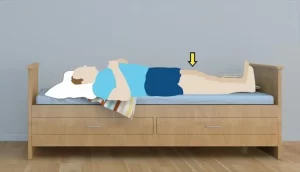
Side-lying straight leg raises
Building the hip abductor muscles, which are found on the side of the buttocks, requires this exercise. Your pelvis is stabilized by these muscles as you walk and stand.
- On the ground or a mat, lie on your right side.
- With your feet placed on top of each other and your legs extended, your body should form a straight line.
- You can either hold your head with your elbow bent or rest your arm straight on the floor below it for support.
- For further support, extend your left hand in front of you or let it rest on your hip or leg.
- Lift your left leg off your lower leg as you release the breath.
- Hold on for a brief while.
- Quit lifting your leg as soon as you feel the muscles in your obliques or lower back contract.
- Take a breath, then bring the leg back down to touch the right leg.
- Return to your neutral position after that.
- Next, unwind.
- Do this five to ten times over.
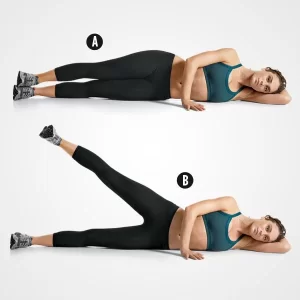
Straight leg raises
Your hip flexor and quadriceps will grow stronger as a result of these leg raises. This is particularly crucial for recovering from surgery and regaining strength.
- Lie comfortably in a supine position on the floor or table to begin.
- Now flex just one knee.
- Next, slowly raise your leg upwards.
- Maintain a straight posture on your opposite knee
- Hold for a short while after that.
- Afterwards, drooping your leg.
- Gradually return to your neutral posture.
- Next, unwind.
- Continue on the opposite side.
- Five to ten repetitions for each side.

Clamshells
This exercises your abductors and the external rotators of your hips. For early ambulation and balance, both are crucial.
- Begin by resting comfortably on one side of the table.
- Tighten your abdomen.
- Now bend your knees.
- Extend your upper knee while keeping your feet together.
- Hold on for a brief while.
- Then drop your leg gradually.
- Return to your neutral position after that.
- Next, unwind.
- Five to ten repetitions for each side.
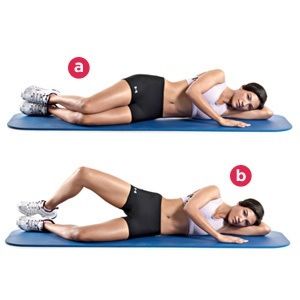
Knee bending
This keeps your range of motion intact before surgery.
- During the workout, keep your shoulders back and down while sitting upright in your chair.
- Get ahead into the center of the place.
- Reposition your foot so that it is as close to the chair as possible on one leg.
- Continue with the other leg, going back to the starting position.
- Next, unwind.
- Make sure to move slowly and purposefully.
- Five to ten repetitions for each side.
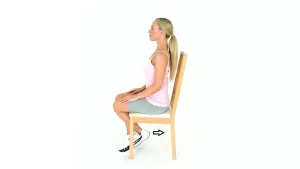
Knee extension
This strengthens the quadriceps muscle across its whole range of action.
- Sit in a stable chair and straighten one of your legs.
- Maintain the position for a few seconds.
- Lower your leg gradually.
- Go to the beginning position and do the same with the opposite leg.
- Then, relax.
- 5 to 10 repetitions on each side.
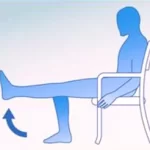
Short arc quadriceps exercise
This exercise can enhance the knee joint’s proprioception. promotes flexibility and avoids muscular imbalances.
- Set up a rolled blanket beneath your ill knee while lying on the floor or in bed.
- Straighten your leg and knee for 5 seconds and hold the position.
- Slowly lower your leg and take a seat.
- Make sure the back of your knee is always in contact with the object and your lower back is always on the floor.
- This exercise also works to strengthen the quadriceps.
- Return to your neutral position after that.
- Then, relax.
- 5 to 10 repetitions on each side.
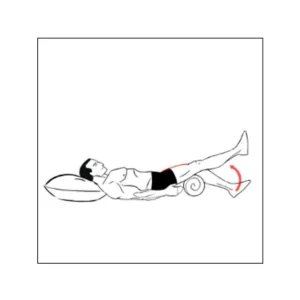
Prone leg raise
This enhances the hamstrings and gluteal muscles. These muscles are necessary for getting into and out of chairs and transportation.
- Begin in a calm prone position on a bed or table.
- Lift your entire leg off the table slowly.
- While attempting to keep a straight knee.
- Take it there for a few seconds.
- Your leg should be lowered.
- Then slowly return to your neutral stance.
- Then unwind.
- Rep 5-10 times on each side.
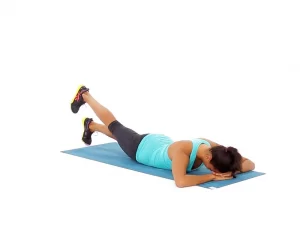
Standing on one leg with support
This practice proves essential for maintaining balance and reducing the risk of falling.
- Begin in a relaxed standing position.
- Reach for the A countertop or waist-level bar for balance.
- Bend your affected knee and elevate your heel toward the ceiling until you reach a comfortable position.
- Maintain this posture for a few seconds.
- Then slowly return to your neutral stance.
- Then unwind.
- Repeat on each side 5-10 times.
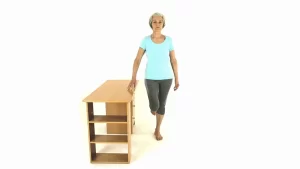
Ankle pumps
Ankle pumps are an easy-to-do but powerful exercise that helps to keep joints mobile, lessen swelling, and stop blood clots.
- Begin by resting or sitting on a solid bed and extending your feet out in front of you.
- These can also be done on the ground as well.
- Point your feet as far as you can toward your knees.
- Then, as far as you can, aim them away from you.
- That’s all there is to it Simply alternate pointing and flexing your feet as far in each direction as you can.
- Continue for roughly 2 to 3 minutes.
- Then unwind.
- Repeat on each side 5-10 times.
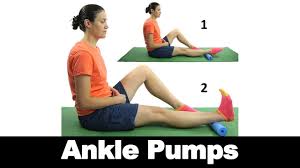
Ankle circles
Additionally, this exercise strengthens the calf muscles, which are essential for supporting and stabilizing the knee.
- Begin by carefully rotating your ankle in circles, first to the left and then to the right.
- Attempting to sketch the alphabet with your foot in the air might even prove to be more convenient.
- Use your big toe as a lead.
- Minimize your movements and concentrate on using just your foot and ankle, not your whole leg.
- Keep going for around two or three minutes.
- Next, relax.
- On each side, repeat five to ten times.
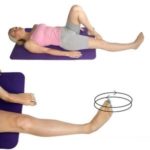
Heel slides (hip and knee flexion)
The muscles, ligaments, and tendons in your legs and hips can be strengthened with heel slides.
- Sit comfortably in a supine position on the bed or table to begin.
- Then, bending at the knees, move the affected leg towards the buttocks.
- Try to touch the buttocks with heels.
- Feel until you find a comfortable position.
- Hold it for a few seconds.
- Straighten your leg now, carefully.
- Return to your neutral position shortly after that.
- Next, unwind.
- Continue on the opposite side.
- Five to ten repetitions for each side.
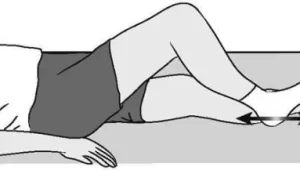
Leg slides (abduction/adduction)
By exercising to strengthen these muscles, one can help avoid pain and potential injury while also restoring range of motion.
- Start with relaxing while lying down on the floor.
- Keep your kneecap indicating upward and extend your leg to the side.
- To get back to the beginning position, slide your leg back.
- Following that, return to your neutral stance gradually.
- Then relax.
- Proceed to the other side.
- Do five to ten repetitions for each side.
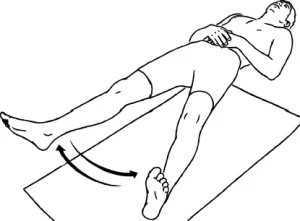
Chair push up
With these exercises, you can get stronger, more balanced, less pain, fitter, and more mobile.
- Take a seat in a wheelchair or a strong armchair.
- Take hold of the chair’s arms.
- Hold down down on the chair’s arms and extend your elbows to lift your lower body out of the seat.
- Hold on for five seconds.
- Return to the chair by lowering yourself gradually.
- Use your knees to help lift your bottom off the chair if your arms are first feeble.
- Return to a neutral stance gradually.
- Then relax.
- Perform five to ten repetitions.
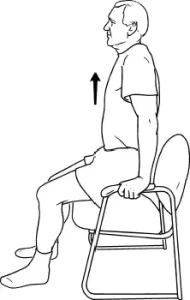
Calf raise
Calf muscles are worked with this exercise. We advise using a chair, counter, or railing for balance when performing this exercise.
- Stand straight on the ground while holding onto the back of a chair.
- Breathe out and raise yourself onto your toes, keeping your legs straight and your balance intact.
- Until you are unable to stand any higher on your toes, keep lifting yourself.
- Hold on for five seconds.
- Then, slowly take a step back to your neutral position.
- Next, unwind.
- Do five to ten times through.
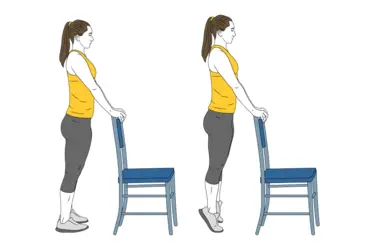
Quad Sets
Quad sets provide stability, improve overall knee function, and support the knee joint by activating and developing the quadriceps.
- Straighten one leg while seated or lying down on a solid bed or the floor.
- Place a little, compacted towel beneath your knee.
- You should have your foot flat on the floor and your other leg bent.
- Tighten your quadriceps, or thigh muscles, in your straight leg by pressing the towel with the back of your knee.
- After maintaining this posture for roughly six seconds, take a ten-second break.
- Perform this exercise on one side five to ten times.
- Then, slowly take a step back to your neutral position.
- Next, unwind.
- After that, switch legs and perform the exercise five to ten times on the opposite side.
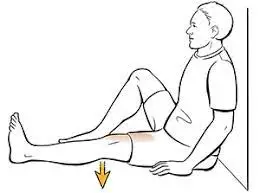
Gluteal Set
With these exercises, joint stabilization is facilitated by strong gluteal muscles.
- Lay flat on your back on a hard bed, or the ground.
- Bend your knees while placing your feet flat on the floor or bed.
- Put as much pressure as you can on your buttocks.
- Hold that position for roughly a few seconds.
- Maintain your knees separate and avoid your desire to lift your hips off the ground or bed.
- Then, slowly take a step back to your neutral position.
- Next, unwind.
- Perform this exercise 5–10 times, or multiple times throughout the day.
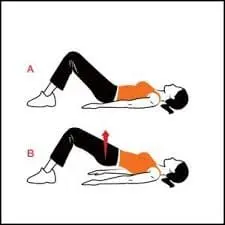
Standing Hip Abduction
Exercises for hip abduction can help you prevent and treat hip and knee pain in addition to giving you a tight, toned rear end.
- Maintain a straight back while standing with your feet pointed forward.
- Keep your posture straight.
- Extend your right leg to the right side until you feel pressure on the outside of your hip and leg.
- Give it a five-second hold.
- Return your leg to the standing position.
- Then relax.
- After that, finish the exercise with your left leg.
- Repeat five to ten times.
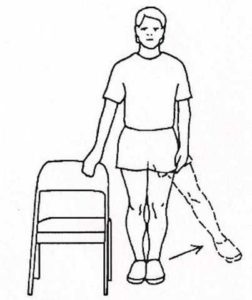
Standing Hip Extension
Activation of the gluteal muscles facilitates full hip extension and upright sitting and standing. This exercise also helps with overall strength in the lower body.
- For balance, stand with your hands on a solid surface, such as a table or countertop.
- Stretch one leg straight out backward toward the ceiling, ensuring that your knee remains mostly straight.
- Maintain this posture while concentrating on tightening your butt muscles.
- Return to your starting position after relaxing your leg.
- Next, unwind.
- Use your other leg to complete the exercise after that.
- Five to ten times, repeat.
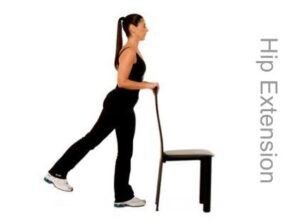
Gentle extension stretch
The seated hamstring stretch can help Increase flexibility and range of motion in your hamstrings.
- Take two chairs and arrange them so that they face each other.
- With your right leg stretched out onto the other chair, take a seat in one chair.
- Until your hamstrings start to stretch, lean forward.
- Work your way up to a few seconds of holding this stretch.
- After that, return to your neutral position by taking a slow step.
- Then relax.
- Do this five to ten times, or several times during the day.
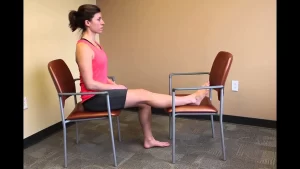
Prone knee bend
Additionally, it is a means of concentrating on and isolating the vastus medialis obliquus muscle, which is critical for knee stability.
- Starting on the bed or table, assume a comfortable prone position.
- Bend your knee to a comfortable posture now, gradually.
- Hold it for a few seconds.
- After that, slowly bring your leg back down to your neutral position.
- Next, unwind.
- Continue on the opposite side.
- Five to ten repetitions for each side.
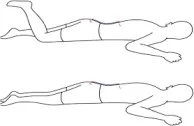
Sitting hamstring stretch
This practice can help you a greater range of motion and flexibility in your hamstrings.
- With your heel on the floor, raise one leg straight in front of you while you sit on the edge of a chair.
- Sitting tall and rolling your legs forward can help straighten the spine.
- For a few seconds, hold this stretch.
- Go back to your neutral posture after that.
- Next, unwind.
- Five to ten repetitions for each side.
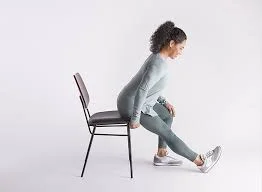
Step-Up
A step-up works the gluteal muscles in the buttocks, as well as the quadriceps and hamstrings, here and here. In general, this is an excellent lower-body conditioning workout.
- Starting from the ground, find a comfortable standing position.
- Afterward, place a footstool on the ground and take one step.
- Extend your affected leg while keeping your back straight.
- Put your other leg on the footrest.
- Hold on for a brief while.
- Return to your neutral position after that.
- Next, unwind.
- Five to ten repetitions for each side.
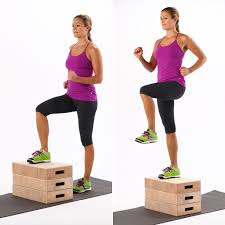
Sitting ball squeeze
The inner thigh muscles are the focus of the adductor ball squeeze. The adductors are a group of muscles that are crucial for knee and lower extremity stability during a variety of daily activities.
- Start by placing your feet flat on the floor and sitting straight at the edge of a chair.
- Put a cushion or ball between your knees.
- Press your thighs together gently, pressing the ball or pillow together.
- After holding for ten seconds, unwind without allowing the ball to fall.
- Return to your neutral position after that.
- Next, unwind.
- Five to ten repetitions for each side.
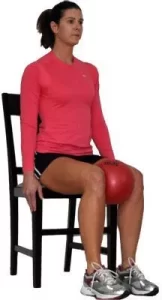
TheraBand Knee Curl in Standing
A resistance band Simple and safe exercises that can help stabilize your knees and relieve back pain are standing leg curls.
- Start by wrapping the exercise leg’s ankle with the band’s center.
- Pulling upward, slowly bend your knee against the band.
- Hold, then slowly make your way back.
- Return to your neutral position after that.
- Next, unwind.
- Five to ten repetitions for each side.
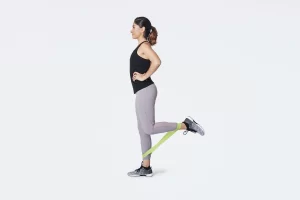
Glut extension
Hip strength and gluteal muscle strength may all be enhanced by strengthening your glutes.
- While lying on your stomach, flex your knee and lift your leg off the bed by using your buttocks.
- Take care not to strain your back.
- Hold, and then return gradually.
- Return to your neutral position after that.
- Then relax.
- Five to ten repetitions for each side.
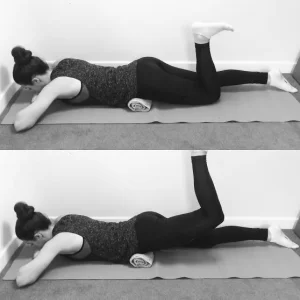
TheraBand Squat Knee
Resistance bands work well because they give you more control over your squat motions, which helps strengthen your abductor, glutes, back, and core.
- Put both of your feet in the band’s middle.
- In each hand, grasp one end of the band.
- Maintain the band’s pressure by keeping your elbows straight.
- As you gradually bend your knees and slant your hips forward a little, maintain your elbows straight.
- Maintain a straight back.
- Hold, and then return gradually.
- Return to your neutral position after that.
- Then relax.
- Five to ten repetitions for each side.
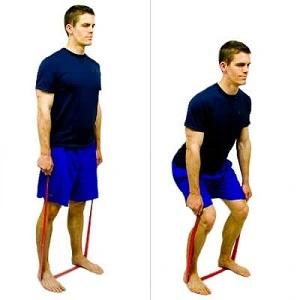
TheraBand Ankle Calf Raise in Standing
This exercise targets your calves specifically, which will increase your stability and strength in lower body exercises that are compound.
- Step on the band with your foot.
- Check that the band fits around your foot’s object rather than your heel.
- With both hands, grab the band, lift it up, and set it on your shoulders.
- Simply hold it in your hands high enough so that there is noticeable tension if it does not stretch this far.
- Raising your heel and coming up on your toes, balance on the foot that is holding the band down.
- For a brief period, hold the highest position while flexing your calf muscles and resisting the band’s tension.
- To begin, slowly lower yourself back (foot flat on the ground).
- Then relax.
- Five to ten repetitions for each side.
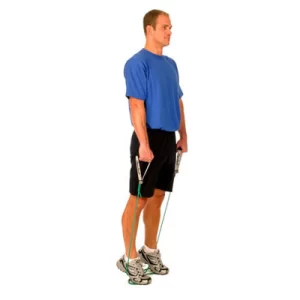
Resistance Band Seated Hamstring Curls
Improving overall knee health by balancing hamstring and quadriceps (front thigh) strength.
- Place a band close to the ground and a bench a couple of feet away.
- Place your feet on the bench and wrap the band around your ankles, starting with your legs straight.
- This is where you will begin.
- Bring your feet closer to the bench by flexing your knees.
- To keep your feet from hitting the floor, you may need to lean back slightly.
- After finishing the movement, pause and slowly return to the starting position.
- Then relax.
- Five to ten repetitions for each side.
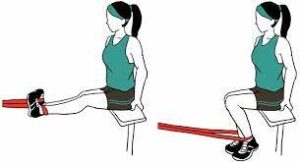
Walking
- You can warm up and cool down after strength training with five minutes of walking.
- Engage in more activities to burn calories and reduce your weight.
- Losing weight can help you heal more quickly and lower your risk of complications if you are overweight.
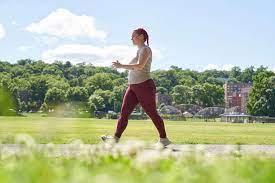
Dos and Don’t:
- If the exercise causes you any pain or discomfort, stop doing it.
- Since every patient is unique, different exercises may be needed to address the specific problem.
- Before beginning your pre-knee replacement surgery exercise program, speak with your physician.
- Exercises to strengthen the knee muscles must be performed every day.
- It is also advisable to repeat them in specific situations.
- Being careful is the best way to take action.
- Avoid making sudden movements while exercising.
- Even if you have only had one leg replaced during your knee replacement surgery, use both legs when you exercise. You should have strong knees on both sides.
Summary
Exercise before surgery is more than just getting in form when it also prepares your body for the best possible recovery from a knee replacement. Better overall fitness, increased flexibility, and stronger muscles all lead to a more quick and painless return to full mobility. Making pre-surgery exercise a priority will result in a faster, more effective knee replacement recovery. Take control of your destiny and move forward into a brighter future.
Communicate with your doctor; they will create an exercise plan that is specific to your needs and restrictions. Gradually increase the pace and intensity. Pay attention to your body and avoid overexerting your abilities. Warming up and cooling down help to prepare your muscles and prevent injuries. Perform these exercises for at least 15 to 25 minutes twice per day.
Your healing will go much more quickly and with better results if you can strengthen the muscles surrounding your knee before the procedure. In order to help prevent blood clots, the following exercises will help improve circulation to your legs and feet. They will also assist in improving knee mobility and muscular strength.
Since each person is unique, make adjustments and pay attention to your body. Communicate with your doctor whether you have any inquiries or worries.
FAQs
Following a knee replacement surgery, you will be able to safely perform the majority of the activities and exercises you were able to perform before, however, it is advised that you avoid severe activities and exercises that put an excessive amount of pressure on your knee implants. Sports involving physical contact, leaping, and using Indian-style toilets are a few examples.
Exercising before your surgery will not only help strengthen your muscles, but will also prepare your mind for the healing process.
Prior to having a knee replacement, you should avoid doing anything that might lead to skin damage to the area around your injured knee. To perform the surgery, surgeons require healthy, without harm skin.
It’s critical to maintain an active lifestyle while awaiting surgery. This is because it will strengthen your muscles, aid in pain relief, and speed up your body’s healing after surgery. Additionally, it will increase your mobility, which will help with daily household tasks like washing and dressing.
Postponing knee replacement surgery can result in increased bone loss, cartilage degradation, and joint deformity as the damage to the joints gets worse. In advanced stages, the surgery may be less successful and more complex due to severe joint damage.
Before having knee replacement surgery, you should perform the following specific exercises (only after consulting a doctor):
Thigh squeezes
Straight leg raises
Clamshell exercise
Bending the knee
Chair push-ups
Increased levels of fitness reduce the possibility of complications during surgery. This is because your body can handle the stress of the surgery better. As a result, the possibility of complications arising increases, allowing you to leave the hospital and return to your normal life sooner.
After surgery, physical therapy, ongoing exercise, and strength training are crucial components of your recovery. During your recovery, it can assist you in managing your pain and enhancing your mental well-being in addition to hastening your healing and increasing your range of motion.
Muscle relaxation, breathing exercises, and meditation are examples of relaxation techniques that can be beneficial.
Prior to surgery, exercise has been shown to facilitate a smooth recovery for patients. Patients who exercise prior to major surgery may be able to prevent common complications like pneumonia, heart issues, and stomach issues.
One of the most crucial things you can do for your health is to exercise daily. Exercise has been shown to improve mental health, help with weight management, reduce the risk of disease, strengthen bones and muscles, and make daily tasks easier.
Aim for at least 30 minutes a day of moderate physical activity as a general goal.
Many individuals have better physical performance later in the day. In comparison to the morning, muscle strength, flexibility, power output, and endurance are all better in the evening.
During exercise, temperature and metabolites occur, which has an effect on the internal environment’s constant state. Depending on the type of exercise, weariness and exhaustion will eventually set in.
Resistance Band Seated Hamstring Curls
TheraBand Ankle Calf Raise in Standing
TheraBand Knee Curl in Standing
Sitting ball squeeze
Gluteal Set
Quad Set
Walking is one of the most important workouts you can do having a knee replacement, aside from physiotherapy exercises. It strengthens the muscles surrounding the new joint and improves mobility. You may probably be provided with walking aids at first to assist you, but within a week or so, you ought to be able to walk on your own.
Your knee pain has grown in intensity and frequency.
Everyone experiences pain differently, but there are some common types of pain that patients should be aware of, such as: Knee pain that continues for more than a few weeks. Knee pain keeps you awake at night. Knee cramps during and after exercise.
Straight leg raises, squats, and modified squats are all good knee exercises. Stretching keeps the knee and leg muscles from becoming overly tight, which can lead to knee pain.
A knee replacement is a major surgery that is typically recommended only after other treatments, such as physiotherapy or steroid injections, have not been successful in relieve pain or improve mobility.
Exercise is a simple and healthy way to relieve minor knee pain caused by overuse, arthritis, or other factors. Knee-strengthening exercises are an effective way to prevent injury and maintain leg strength. Stretching can also help keep muscles flexible, reducing or eliminating pain.
Knee replacement surgery is typically performed on elderly patients with severe arthritis, but those under the age of 50 are considered to be young and should delay the procedure until the age of 65. This is because the artificial joints used during knee replacement surgeries last only 15 to 20 years.
The condition of arthritis contributes significantly to weak knees because it causes joint inflammation and degeneration. The most common type affecting the knee is developing osteoarthritis in which protective cartilage protects the ends of bones and gradually wears away over time.
Quadriceps (front of thigh)
Hamstrings (back of thigh)
Abductors (Outer Thigh)
Adductors (Inner Thigh)
Gluteus medius and gluteus maximus (buttocks).
Arthritis-related pain is the most common reason for knee replacement surgery. People who need knee replacement surgery usually have difficulty walking, climbing stairs, and getting out of chairs. If just one part of the knee has been harmed, surgeons can usually replace that part.
Having both knees replaced at the exact same time enables patients to return to their normal lives faster. Patients undergo a single surgery, a single hospitalization, and a single course of rehabilitation. Patients tend to take less time off from occupation.
References:
- Greengard, S. April 13, 2020. Ten Exercises to Build Muscle Before Getting a Total Knee Replacement. Exercises for Total Knee Replacement Surgery: https://www.healthline.com/health/thigh-squeezes Citation inside the text: Greengard (2020)
- Moskal, J. T. (January 4, 2012). Results of Total Knee Arthroplasty for Patients and Clinicians. Knee Surgery, JBJS Orthopaedic Highlights, 2(1). The URL is 10.2106/jbjs.ks.k.00175. Reference within the text: Moskal, 2012
- Rahman, M. June 15, 2021. The file BBRC_Vol_14_No_05_Special-Issue_42.pdf can be accessed at https://bbrc.in/wp-content/uploads/2021/06. Research Communications in Bioscience and Biotechnology, 14(5), 242-244. The URL is 10.21786/bbrc/14.5/43. Reference within the text: Rahman, 2021
- Hollander, R. (November 24, 2020). Exercises for PRE-habilitation should be done before knee replacement surgery. Alpine Spine & Physical Therapy, Inc. Pre-surgery knee replacement exercise: https://www.alpinephysicaltherapy.com/2020/06/02 Reference inside text: (Hollander, 2020)
- S. Bhatia (2023, Nov. 24). Exercises that may be beneficial both before and after knee replacement surgery. PharmaEasy Blog. These exercises could benefit you both before and after a knee replacement surgery: https://pharmeasy.in/blog/ Reference inside text: (Bhatia, 2023)
- Miller, M. (May 31, 2023). Preparation Exercises for a Successful Knee Replacement. https://foothillsrehab.com/blog/10-prehab-exercises-knee-replacement/ Foothills Physical Therapy & Sports Medicine – Phoenix Metro Reference within the text: Miller, 2023
- Before undergoing knee replacement surgery, try these three exercises | Performance Health (n.d.). Exercises to Perform Before Your Knee Replacement Surgery: https://www.performancehealth.com/articles/13 Reference inside text: (13 Activities for Your Knee Replacement | Performance Health, n.d.)
- 13 Workouts to Perform Prior to Knee Replacement Surgery | Performance Health. (n.d.). Exercises to Perform Before Your Knee Replacement Surgery: https://www.performancehealth.com/articles/13 Reference inside text: (13 Activities for Your Knee Replacement | Performance Health, n.d.)
- Briones, L. July 8, 2022. Before knee surgery, perform these five exercises for pre-rehabilitation. The website of Endeavor Clinical Trials provides five pre-rehabilitation activities to perform before knee surgery. Reference within the text: Briones, 2022
- Image 1, My Doctor Online article (n.d.). quad thigh squeezes (1143875) https://mydoctor.kaiserpermanente.org/ncal/article Reference within the text: (My Doctor Online, n.d.)
- Image 5, Passive Knee Flexion Sitting. (February 3, 2022). You may see it on YouTube at https://www.youtube.com/watch?v=C0z9db2gdG8. (Knee Flexion Passive Sitting, 2022) In-Text Citation
- Image 9, B. (2017, August 28). Stages of Knee Osteoarthritis. YouTube. https://www.youtube.com/watch?v=BBqjltHNOrc In-Text Citation: (2017)
- Image 13, Adduction/Abduction of the Hips with the Knee Extended (Supine). (As of now). The URL for this page is https://iris.hattiesburgclinic.com/patadv/exkit/Orthopedic/English/0290000680knhp050m_English.html.
- Image 14, Chair Push-Up. (n.d.). The link is https://iris.hattiesburgclinic.com/patadv/exkit/Geriatric%20Resource%20Library/English/0300000439sitn3m_English.html. Citation inside the text: (Chair Push-Up, n.d.)
- Image 15, Workouts, routines, and exercises related to chair-assisted calf raises. (As of now). Chair-assisted Calf Raises: https://www.workoutsprograms.com/exercises Reference inside text: (WORKOUTS, ROUTINES, AND CHAIR ASSISTED CALF RAISES – Exercises, n.d.)
- Image 16, Quad Set for Leg and Knee. (As of now). Saint Luke’s Health System. quad-set, leg, and knee Reference within the text: Quad Set for Leg and Knee, n.d.
- Image 20, O. N. (2016, February 24). Seated Hamstring Stretch With Chair. YouTube. https://www.youtube.com/watch?v=P3rK-zhrUwg In-Text Citation: (2016)
- Image 24, Kislow, D. (November 10, 2016). You Can Still Use a Chair to Work Out Your Upper Body. Pinterest. PIN: 56787645282760724; https://in.pinterest.com/ Reference inside text: (Kislow, 2016)
- Image 25, Rogers, P. July 29, 2022. Leg Curls: Correct Way, Modifications, and Most Common Errors. incredibly well-fitting. This page explains how to perform the leg curl exercise correctly (3498304). Reference within the text: Rogers, 2022
- Image 26, H. (March 30, 2017). Hannah’s Joyful Tempo. Hannah’s Joyful Tempo. Hannah’s Happy Pace, Inc. In-text Reference: (2017)
- Image 27, Knee Pain Explained: Theraband Exercises for Legs. (n.d.). Pain-In-Knees-Explained.com Theraband Leg Exercises: https://www.knee-pain-explained.com/en.html Reference within the text: Theraband Leg Exercises – Knee Pain Explanation, n.d.
- Image 28, Performance Health Academy: Exercises (n.d.). body_parts=23&movement= 1691 in https://www.performancehealthacademy.com/exercises.html Reference within the text: Performance Health Academy, “Exercises,” n.d.

